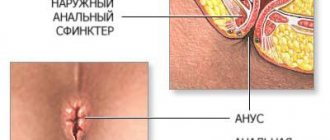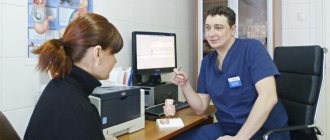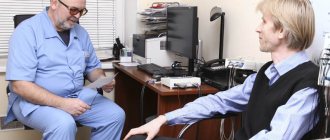All iLive content is reviewed by medical experts to ensure it is as accurate and factual as possible.
We have strict sourcing guidelines and only link to reputable sites, academic research institutions and, where possible, proven medical studies. Please note that the numbers in parentheses ([1], [2], etc.) are clickable links to such studies.
If you believe that any of our content is inaccurate, out of date, or otherwise questionable, please select it and press Ctrl + Enter.
According to the clinical course, paraproctitis is divided into acute and chronic.
Acute paraproctitis is a purulent inflammation (abscess) of the peri-rectal tissue.
[1], [2], [3], [4], [5], [6], [7], [8], [9]
Symptoms of acute paraproctitis
The disease has a short (no more than 3 days) prodromal period, during which weakness, headache, and general malaise may be observed. Then typical symptoms of paraproctitis appear: chills, fever, pain in the perineum. The severity of clinical symptoms is determined by the reactivity of the body, the type of bacteria that caused the inflammatory process, as well as which of the fascial-cellular spaces is affected. When the cellular spaces of the small pelvis are affected by the type of phlegmon, the clinical picture is dominated by general symptoms caused by intoxication. As the process progresses and an abscess forms, the intensity of the pain increases and it becomes throbbing. Depending on the intensity of the inflammatory process, this period lasts from 2 to 10 days. Then, if surgical treatment is not performed, the inflammation spreads to the adjacent cellular spaces of the pelvis, and the abscess empties into the rectum or onto the skin of the perineum. After opening the abscess, there are 3 possible outcomes:
- recovery;
- formation of rectal fistula (chronic paraproctitis);
- development of recurrent paraproctitis with more or less frequent exacerbations of the inflammatory process.
Chronic paraproctitis is a consequence of acute inflammation. This is a perirectal fistula, formed after spontaneous opening of an abscess or opening it surgically. The internal opening of a fistula is a defect in the rectum. The external opening is located on the skin of the perineum. In some cases, several fistula tracts and several external openings of the fistula can be observed.
Diagnostics
Diagnosis of any type of inflammation of the perirectal tissue includes confirmation of the diagnosis based on existing symptoms, as well as differentiation of pathology from other proctological anomalies:
- teratomas of perirectal tissue;
- abscess of Douglas space;
- rectal tissue cysts;
- osteomyelitis of the lower spine;
- epithelial coccygeal duct;
- tuberculous fistulas and fistulas due to Crohn's disease.
To confirm paraproctitis, in addition to collecting anamnesis and complaints, use:
- laboratory blood test (a purulent process is indicated by an increase in leukocytes, neutrophils and ESR);
- physical examination of the rectum and perianal area (digital examination);
- anoscopy and sigmoidoscopy (these types of studies are not used for acute inflammation due to their pain and risk of sphincter spasm);
- canal probing or fistulography (x-ray contrast study);
- X-ray of the pelvic organs with or without contrast.
Diagnostic data helps to detect a purulent focus and all its ducts in order to choose the right treatment tactics.
Symptoms of chronic paraproctitis
Symptoms of paraproctitis of this form are a consequence of acute. In cases where, when opening the abscess, the internal opening in the rectum is not eliminated, a rectal fistula (chronic paraproctitis) may subsequently form. A rectal fistula is characterized by the presence of one or more external openings in the skin of the perineum near the anus. Pus, sometimes feces and gases can be released from the external openings of the fistula tract.
The general condition of patients with chronic paraproctitis “suffers” little. Pain is not the main symptom of the disease. It appears only when the process worsens. The nature and amount of discharge from the fistula depends on the activity of the inflammatory process. It should be noted that while the fistula is functioning (its external opening is open), relapses of acute paraproctitis rarely occur. At the same time, there is a special form of so-called acute recurrent paraproctitis. With it, a pinpoint internal opening in the rectum can be temporarily closed with a soft scar, and the fistula ceases to function. If the scar is damaged, paraproctitis recurs.
Depending on the location of the fistula tract in relation to the sphincter muscle, 4 types of fistulas are distinguished:
- subcutaneous-submucosal, or intrasphincteric, - the fistulous tract is located under the mucous membrane or in the subcutaneous tissue medially from the sphincter muscle;
- transsphincteric - the fistulous tract is directed from the intestine to the outside through the thickness of the sphincter;
- complex, or extrasphincteric, - the fistulous tract goes around the sphincter from the outside. With this form of fistula, the internal opening is usually located at the upper pole of the sphincter. Complex fistulas can be horseshoe-shaped. In these cases, the internal opening of the fistula, located along the posterior wall of the rectum, gives rise to two fistulous tracts, which open on the skin with two openings on either side of the anus;
- incomplete fistulas have only an internal opening in the rectum and no external opening in the perineum. The source of their formation is often an anal fissure.
The rectum is the final element of the gastrointestinal tract (GIT). Its inner surface is covered with mucous membrane, and on the outside it is surrounded by loose fatty tissue. For various reasons, the organ can become inflamed. If the mucous membrane is inflamed, the disease is called proctitis, if the tissue is inflamed, it is called paraproctitis. In both cases, the patient needs immediate treatment.
Treatment of subcutaneous paraproctitis
First of all, it is worth saying that paraproctitis cannot be treated at home. This is a serious disease that requires professional consultation, thorough examination and specialized treatment.
Treatment of paraproctitis without surgery is not carried out; conservative therapy is used as an additional method. Operations are performed under local or general anesthesia, using conduction methods, such as spinal or epidural anesthesia.
The choice of method depends on the area of tissue involved in the inflammatory process and the general condition of the patient. Proctological surgeons use the two most common methods of surgical intervention for paraproctitis:
- Excision of subcutaneous paraproctitis within unchanged tissues with simultaneous removal of the pathological gland, which constantly provokes the resumption of purulent inflammation. After the operation, a large wound surface remains, which requires deep sutures and long-term care, constant dressings with treatment with an antiseptic and hydrophilic ointment;
- Opening an abscess with the installation of drainage is the most common type of operation, the essence of which is to open a purulent cavity through the skin, followed by washing out the purulent masses and washing with antiseptic solutions and applying a bandage until complete cleansing, the appearance of granulation and healing. This type of operation is associated with the risk of relapse of paraproctitis, and in the same place, since the cause is an inflamed anal gland in the crypt. Often a chronic form of paraproctitis develops with the formation of a purulent fistula with deformed walls of dense connective tissue. A person may suffer from this form of the disease for a long time; periods of inflammation periodically occur, and then purulent contents may leak from the fistula tract.
Drug treatment of subcutaneous paraproctitis consists of the use of powerful antibacterial agents and even a combination of two antibiotics and antiprotozoal drugs. In recent years, antibacterial drugs have been selected taking into account the sensitivity of the flora, which is determined during bacteriological testing. Medicines are prescribed for parenteral administration in the form of injection solutions and droppers. Painkillers are administered and powerful detoxification therapy with crystalloid solutions is carried out. All these measures help prevent complications and relapse of paraproctitis.
The multidisciplinary Yusupov Hospital uses gentle surgical techniques. This significantly shortens the postoperative period, reduces pain and, most importantly, significantly reduces the risk of recurrence of the disease and the formation of so-called ligature fistulas. You can make an appointment with a proctologist at the Yusupov Hospital by calling the 24-hour hotline.
Causes of inflammation of the rectum
Diseases may be of an allergic nature. But more often they are caused by opportunistic bacteria, which are constantly present inside the organ and lead to inflammation only in the presence of provoking factors. Less commonly, viruses that enter the intestinal tissue with the blood. The inflammatory process can be a consequence of sexually transmitted infections.
- frequent constipation/diarrhea;
- poor nutrition;
- weakened immune system;
- undergoing radiation therapy;
- taking antibacterial drugs.
The diseases often occur in patients suffering from food allergies, Crohn's disease, and ulcerative colitis. Hemorrhoids and anal fissures contribute to their occurrence. Pathologies can develop as a complication of sepsis, influenza or sore throat.
Reasons for development
There are many factors that can contribute to the development of pathology. Among them:
- Frequent bowel disorders or constipation
- Infectious bowel diseases, E. coli
- STD
- Haemorrhoids
- Traumatization of the rectum
- Untreated anal fissures
- Colitis
- Crohn's disease
- Decreased immunity
- Poor nutrition – predominance of fatty and spicy foods in the menu
- Alcohol abuse
- Specific physical activity, lifting heavy objects
- Failure to comply with hygiene standards
The combination of reasons determines the main category of patients of the proctologist - most often men aged 25-50 years turn to the doctor with paraproctitis.
Symptoms of acute proctitis and paraproctitis
Pathologies develop as an acute inflammatory process. Its clinical picture is identical in both cases. This is due to the close proximity of the mucous membrane and fiber of the rectum.
Local symptoms
- constipation/diarrhea;
- fecal incontinence;
- discharge of mucus, pus, and sometimes blood from the anus;
- a feeling of empty bowels and a constant desire to go to the toilet;
- itching and pain around the anus, aggravated by defecation;
- pain on the left side of the abdomen, in the perineum (sometimes radiating to the genitals or lower back).
General symptoms
- weakness;
- headache;
- skin rashes;
- loss of appetite;
- weight loss;
- aches and pain in muscles;
- increase in body temperature to +38…+39 o C, chills.
Possible consequences
Lack of treatment for acute proctitis leads to the disease becoming chronic. Against this background, anal fissures often appear, and the inflammation spreads to the fatty tissue and causes paraproctitis. All this provokes the formation of malignant tumors in the tissues of the rectum.
Paraproctitis is accompanied by the formation of a large amount of pus. This usually leads to the formation of a fistula, which finds its outlet near the anus. Sometimes the abscess breaks through. Then the purulent masses spread in the abdominal cavity, causing peritonitis and involving other organs in the inflammatory process. This can lead to blood poisoning (sepsis).
How to diagnose paraproctitis
Purulent paraproctitis
The patient has only one option - see a doctor. In case of an acute process, go to the emergency room of any surgical hospital. The doctor will examine the patient and may need a digital rectal examination. This procedure is extremely painful, so it is performed under local or general anesthesia in a full-scale operating room.
How are pathologies treated?
Despite the similarity of clinical manifestations, proctitis and paraproctitis are treated differently. Treatment of inflammation of the mucous membrane is conservative. If the inflammatory process affects the intestinal tissue, surgical intervention is required.
Conservative therapy
The goal of therapy is to stop the inflammatory process. For this, the patient is prescribed antibiotics (Ceftriaxone, Medaxone) and antimicrobial agents (Biseptol, Bactrim). To rinse the rectum, enemas are done with Collargol, furatsilin solution or warm chamomile infusion. When the symptoms of inflammation decrease, sitz baths in a weak solution of potassium permanganate and oil microenemas are additionally prescribed.
Treatment of proctitis includes diet. The patient is recommended to exclude fatty, spicy, spicy foods, alcohol, and high-fiber foods from the diet. After recovery, he is advised to consume more dietary fiber along with fruits, vegetables and grains to prevent constipation.
Surgical intervention
Paraproctitis requires emergency surgery. It is carried out immediately after diagnosis using general anesthesia. During this procedure, the abscess is opened, its contents are removed, and the cavity is washed with an antiseptic solution.
To prevent relapse and complications, the operated patient is prescribed a course of antibiotics. Wounds are treated daily with antiseptics or antimicrobial agents. In the postoperative period, it is necessary to follow a diet. It prohibits the consumption of foods that cause gas formation and contain large amounts of fiber, spicy and fatty foods.
If symptoms of proctitis and paraproctitis appear, contact your doctor. An experienced proctologist will see you, make an accurate diagnosis and prescribe effective treatment. If necessary, you will receive emergency care immediately after diagnosis.
How long does the healing process take?
In the first week after surgical treatment of a fistula, the patient may experience moderate pain, which can be controlled with painkillers. The period of forced disability is minimal. After surgical treatment of a fistula or paraproctitis, a period of follow-up treatment at home is necessary using sitz baths 3-4 times a day. It is recommended to add dietary fiber or laxatives to the diet. To prevent contamination of underwear, you can use gauze bandages or pads. Normal stool has no effect on wound healing.
Paraproctitis – anal fistula (rectal fistula)
Acute or chronic purulent “melting” of tissue in the anal area, leading to the formation of a fistula canal and, accordingly, a fistula opening. The main diagnostic signs of this serious disease are complaints of pain in the anus, the presence of a fistula opening and discharge from it, including purulent discharge, and swelling of the perineum.
Making a diagnosis by a proctologist is not difficult.
To clarify the nature and location of the fistula tract, an instrumental examination is carried out - anoscopy or retroromanoscopy, ultrasound or MRI.
Prognosis and prevention
With timely treatment, the prognosis for recovery is good. In the absence of medical care, acute forms of paraproctitis always progress to the chronic stage, and they are complicated by the spread of infection, purulent melting and necrosis of the pelvic organs, and sepsis.
To prevent paraproctitis, careful hygiene of the perianal area, adherence to PN standards to maintain normal stools, as well as timely treatment of proctological diseases are recommended.









